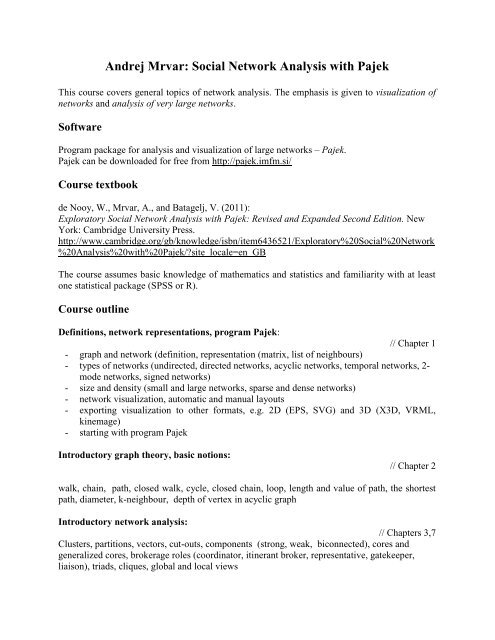Andrej Mrvar: Social Network Analysis with Pajek
Andrej Mrvar: Social Network Analysis with Pajek Andrej Mrvar: Social Network Analysis with Pajek
Andrej Mrvar: Social Network Analysis with PajekThis course covers general topics of network analysis. The emphasis is given to visualization ofnetworks and analysis of very large networks.SoftwareProgram package for analysis and visualization of large networks – Pajek.Pajek can be downloaded for free from http://pajek.imfm.si/Course textbookde Nooy, W., Mrvar, A., and Batagelj, V. (2011):Exploratory Social Network Analysis with Pajek: Revised and Expanded Second Edition. NewYork: Cambridge University Press.http://www.cambridge.org/gb/knowledge/isbn/item6436521/Exploratory%20Social%20Network%20Analysis%20with%20Pajek/?site_locale=en_GBThe course assumes basic knowledge of mathematics and statistics and familiarity with at leastone statistical package (SPSS or R).Course outlineDefinitions, network representations, program Pajek:// Chapter 1- graph and network (definition, representation (matrix, list of neighbours)- types of networks (undirected, directed networks, acyclic networks, temporal networks, 2-mode networks, signed networks)- size and density (small and large networks, sparse and dense networks)- network visualization, automatic and manual layouts- exporting visualization to other formats, e.g. 2D (EPS, SVG) and 3D (X3D, VRML,kinemage)- starting with program PajekIntroductory graph theory, basic notions:// Chapter 2walk, chain, path, closed walk, cycle, closed chain, loop, length and value of path, the shortestpath, diameter, k-neighbour, depth of vertex in acyclic graphIntroductory network analysis:// Chapters 3,7Clusters, partitions, vectors, cut-outs, components (strong, weak, biconnected), cores andgeneralized cores, brokerage roles (coordinator, itinerant broker, representative, gatekeeper,liaison), triads, cliques, global and local views
<strong>Andrej</strong> <strong>Mrvar</strong>: <strong>Social</strong> <strong>Network</strong> <strong>Analysis</strong> <strong>with</strong> <strong>Pajek</strong>This course covers general topics of network analysis. The emphasis is given to visualization ofnetworks and analysis of very large networks.SoftwareProgram package for analysis and visualization of large networks – <strong>Pajek</strong>.<strong>Pajek</strong> can be downloaded for free from http://pajek.imfm.si/Course textbookde Nooy, W., <strong>Mrvar</strong>, A., and Batagelj, V. (2011):Exploratory <strong>Social</strong> <strong>Network</strong> <strong>Analysis</strong> <strong>with</strong> <strong>Pajek</strong>: Revised and Expanded Second Edition. NewYork: Cambridge University Press.http://www.cambridge.org/gb/knowledge/isbn/item6436521/Exploratory%20<strong>Social</strong>%20<strong>Network</strong>%20<strong>Analysis</strong>%20<strong>with</strong>%20<strong>Pajek</strong>/?site_locale=en_GBThe course assumes basic knowledge of mathematics and statistics and familiarity <strong>with</strong> at leastone statistical package (SPSS or R).Course outlineDefinitions, network representations, program <strong>Pajek</strong>:// Chapter 1- graph and network (definition, representation (matrix, list of neighbours)- types of networks (undirected, directed networks, acyclic networks, temporal networks, 2-mode networks, signed networks)- size and density (small and large networks, sparse and dense networks)- network visualization, automatic and manual layouts- exporting visualization to other formats, e.g. 2D (EPS, SVG) and 3D (X3D, VRML,kinemage)- starting <strong>with</strong> program <strong>Pajek</strong>Introductory graph theory, basic notions:// Chapter 2walk, chain, path, closed walk, cycle, closed chain, loop, length and value of path, the shortestpath, diameter, k-neighbour, depth of vertex in acyclic graphIntroductory network analysis:// Chapters 3,7Clusters, partitions, vectors, cut-outs, components (strong, weak, biconnected), cores andgeneralized cores, brokerage roles (coordinator, itinerant broker, representative, gatekeeper,liaison), triads, cliques, global and local views
Centrality measures and measures of prestige:- unit centrality measures (degree, closeness, betweenness centrality)- network centralisation- influence domain- proximity prestige- hubs and authorities// Chapters 6, 9<strong>Analysis</strong> of two-mode networks:// Chapter 5- definition of two-mode networks- indirect analysis of two mode networks: transforming two-mode networks to ordinaryvalued networks- normalisations of obtained valued networks- line islands- direct analysis of two mode networks: blockmodelingSigned graphs:- definition of a signed graph- balanced and partitionable signed graphs- inconsistency (error) of given partition of vertices- searching for optimal structural balance partitions using local optimisation- relaxed structural balance// Chapter 4<strong>Analysis</strong> of very large networks, example genealogies:// Chapter 11- programs for entering kinship data- representation of genealogies by graphs (Ore graph, p-graph and bipartite p-graph)- advantages and disadvantages of the presentations- analysis of genealogies (searching for relatives, predecessors, successors, relinkingmarriages)Blockmodeling:- introduction to blockmodeling- equivalences (structural, regular equivalence, other types)- determining blockmodels (indirect and direct approaches)// Chapter 12



